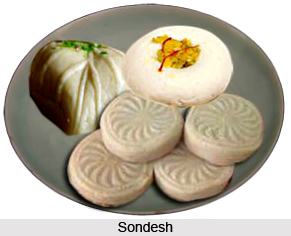 Sondesh is a Traditional Bengali Sweet prepared with milk, sugar and other ingredients. It has soft texture and it can be of various flavours, sizes and shapes. According to folks, Sondesh has a clear meaning attached to it. In Hindi, Sondesh is called as "Sandesh" with a difference in the spelling and another meaning of Sandesh in Hindi is "news". Therefore, Sondesh has become an inherent part of Bengali culture and festivity as Bengali people prefer to break any auspicious news with sweets like Sondesh.
Sondesh is a Traditional Bengali Sweet prepared with milk, sugar and other ingredients. It has soft texture and it can be of various flavours, sizes and shapes. According to folks, Sondesh has a clear meaning attached to it. In Hindi, Sondesh is called as "Sandesh" with a difference in the spelling and another meaning of Sandesh in Hindi is "news". Therefore, Sondesh has become an inherent part of Bengali culture and festivity as Bengali people prefer to break any auspicious news with sweets like Sondesh.
Ingredients of Sondesh
•1 litre milk pre-boiled and top cream removed
•1/2 tsp. citric acid or juice of 1 lemon
•2 tsp. corn flour
•1/2 cup sugar ground fine
•1/4 tsp. essence of choice
•Few drops colour to match essence flavour
Ingredients of Topping
•1 tsp. slivered pistas and almonds
•1/4 tsp. cardamom powder
•Small moulds of choice
Method of Preparing Sondesh
•Dissolve acid or lemon juice in 1/2 cup warm water.
•Put milk to boil. When it rises, pour acidic water all over it.
•Reduce heat and stir till fully curdled. When whey and water separate completely, remove from heat. Strain in clean muslin cloth. Hold under running water for a minute. Press out excess water and hang for 15 minutes (Paneer is made).
•Empty the Paneer in a large plate.
•Take 2 tbsp. of Paneer in a heavy pan and add corn flour. Heat on medium flame stirring continuously for 3-4 minutes.
•Cool, add to Paneer in plate, sugar, essence and colour. Mix till very smooth. Lightly grease and dust moulds with ghee and corn flour.
•Mix topping ingredients. Sprinkle little topping in each mould. Press Paneer mixture into it and level top.
•Chill for 3-4 hours.
•Un-mould carefully.
•Serve chilled.
Sondesh is easy to make and can be prepared at home. The only problem with Sondesh is it does not last long so it is better to consume it as soon as possible. It is so common among the Bengalis that many prefer to have it after a meal on a regular basis. Sondesh can also be seen at any Indian celebration or occasion such as wedding, Diwali, birthday party etc.




















